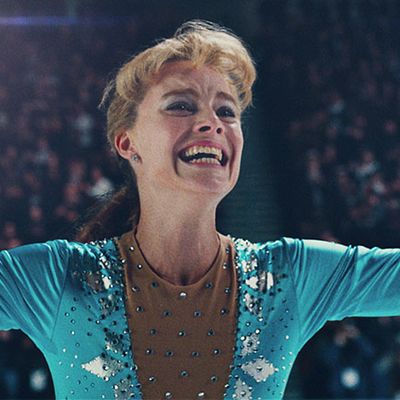
It’s been a strange year for Hollywood (to say the least), full of resistance and revelations. Still, the industry is determined to celebrate — and this week we look at a few of the performances, directors, achievements, and, in one case, prosthetic jowls most likely to be honored.
Every year before Labor Day, audiences and film critics ready themselves for the annual rush of biopics, those prestige one-offs amid the sea of sequels. The timing is purposeful. Awards season begins in autumn and biopics win awards. Because they tend to feature actors transforming and/or pretending to age, you can see the acting — and voters vote for acting you can see. Sometimes you can almost see the Oscar hovering over an actor’s head like the phantom dagger in Macbeth: “Come, let me hold you.”
Ready for a list? The number of biopics already out or set to open by December’s end is staggering. Most anticipated by awards handicappers are the old-fashioned English Great Man saga Darkest Hour, with Gary Oldman unrecognizable as Winston Churchill on the eve of Dunkirk, and the newfangled ironic mockumentary I, Tonya in which different recollections of the rise and fall of Tonya Harding (Margot Robbie) are woven into the narrative. You can see John Travolta as the Dapper Don in Gotti, Hugh Jackman as P. T. Barnum in The Greatest Showman, Chadwick Boseman as Thurgood Marshall in Marshall, Liam Neeson in Mark Felt: The Man Who Brought Down the White House, and Judi Dench as Queen Victoria in Victoria and Abdul. The maker of one of the worst movies of all time, The Room, gets his own biopic, The Disaster Artist, starring James Franco. Biopic specialist Aaron Sorkin’s directorial debut, Molly’s Game, is based on the autobiography of a woman (played by Jessica Chastain) who ran a high-stakes poker game — it’s an auto-biopic. Quasi-biopics that ride in on the Great Man/Woman wave include Steven Spielberg’s The Post, in which Tom Hanks and Meryl Streep play the Washington Post’s Ben Bradlee and Katharine Graham at a key moment in American history, and The Current War, in which Benedict Cumberbatch’s Thomas Edison takes on Michael Shannon’s George Westinghouse and Nicholas Hoult’s Nikola Tesla over the burning question of AC vs. DC.
That’s an impressive range of films with an impressive range of artists—and yet skepticism of biopics is hard to shake. In part it’s the nakedness of the Oscar bait. But it’s also that the history of the genre is riddled with howlers, clunkers, and outright attempts to rewrite history to conform to prevailing social-political values.
Are those charges still applicable, or is it time for a reassessment?
The old-style “Great Man” biopics are more alike than unalike. They skip along the surface, hitting their formative traumas and/or epiphanies with metronomic predictability en route to the triumph that has us watching in the first place. They use artistic license to the point of distorting the meaning of the lives they pretend to interpret. They view history exclusively as the product of extraordinary individuals rather than social or economic currents, and often prize celebrity as an end in itself. They are too choppy, too spread out, and too fatuously tied up in neat little Freudian packages. Their dialogue is often hilariously on-the-nose.
In his study Bio/Pics, George F. Custen writes that slightly less than 300 such films were produced by major studios between 1927 and 1960, propagating “official” versions of great lives. Austro-Hungarian Jewish émigré Paul Muni became the form’s mascot. Between 1936 and 1939, Muni played Louis Pasteur (Oscar, Best Actor), Emile Zola, and the 19th-century Mexican politician Benito Juárez, with time in between to star as the Chinese farmer Wang in the movie adaptation of Pearl S. Buck’s novel The Good Earth. Greer Garson was a dogged Marie Curie and Don Ameche a buoyant Alexander Graham Bell. James Cagney kept World War II spirits from flagging as George M. Cohan in Yankee Doodle Dandy, and Cary Grant played a distinctly heterosexual Cole Porter in Night and Day. John Wayne showed Asia who was boss as Genghis Khan in The Conqueror. Custen argues that biopics were “powerful materials in building a consensus on what constitutes history, and on what kind of history shall be constituted.” Film even strives to argue, he says, “what properly constitutes a life.”
But even in old Hollywood the form could be healthily subverted. Dennis Bingham’s Whose Lives Are They Anyway?: The Biopic As Contemporary Film Genre makes a passionate case for biopics by celebrating the deconstructors, beginning with Orson Welles in the trickiest “Great Man” faux-documentary of all: Citizen Kane, a hotfoot both to publisher William Randolph Hearst (on whom Charles Foster Kane is loosely based) and the genre itself. A newsreel recounting Kane’s death doesn’t scratch the surface. Interviews conducted by a reporter (Joseph Cotten) yield only fragments of truth. “Rosebud” remains elusive. Citizen Kane has had a huge influence on the last half-century of biopics — along with David Lean’s Lawrence of Arabia, which gestures toward the Great Man sort of film (and has the magisterial look and feel of one) before its hero’s participation in atrocities and mental disintegration drive all the high-flown romanticism into a ditch.
Was that the beginning of a “warts and all” approach to even iconic subjects? Martin Scorsese’s The Aviator views Howard Hughes through the lens of his growing mental illness. Aaron Sorkin in his scripts for The Social Network and Steve Jobs opts to spotlight the warts of contemporary capitalist icons. In the former, he makes subsidiary characters look better than they actually were to make Mark Zuckerberg more callous and vindictive. Still further in the anti-hagiography direction is last year’s Ray Kroc biopic, The Founder, the very title of which is barbed. Norman Vincent Peale acolyte Kroc (Michael Keaton) takes the credit away from the true founders, the McDonald brothers, whom he drove from the business.
Beginning with Ed Wood (1994), Scott Alexander and Larry Karaszewski loom equally large in the modern biopic movement. All the clichés are there, from the plucky hero’s poverty to creative epiphany to artistic triumph—but in the service of one of the least talented filmmakers who has ever lived. The joke is that someone like Wood is even getting a biopic! Alexander and Karaszewski bring a similar irreverent sensibility to Larry Flynt in The People vs. Larry Flynt, and in Man on the Moon they have Jim Carrey’s Andy Kaufman make fun of how little the film captures him. It was a short step to Shari Springer Berman and Robert Pulcini’s marvelous American Splendor, in which the real Harvey Pekar is skeptical of his fictional counterpart (Paul Giamatti) — and Giamatti’s Pekar is similarly skeptical of the lead in a play based on his work. The meta is dizzying. Can biopics get anywhere near the truth?
The Great Man/Great Woman biopic has hardly gone away, but for every square, decades-spanning Academy Award winner like Gandhi, there are films that take a narrower focus. Spielberg’s Lincoln isn’t birth-to-death or even election-to-death. It audaciously begins as the Civil War is ending, when two black soldiers tell the president (Daniel Day-Lewis) that the war — and the high-flown rhetoric of the Gettysburg Address — isn’t enough. And so Tony Kushner’s script focuses on the legislative minutiae behind the Thirteenth Amendment. (Lincoln was in part based on Doris Kearns Goodwin’s Team of Rivals in the hope that Barack Obama’s presidency would be a Lincolnesque coming together. How naïve we were.) Similarly, Ava DuVernay’s Selma viewed Martin Luther King (David Oyelowo) as not just an orator but a player who understood how to make short-lived politics serve long-term ideals. DuVernay’s decision to portray LBJ as possibly aiding and abetting J. Edgar Hoover’s blackmail/smear campaign of King raised another biopic bugaboo: How faithful should one be to the historical record? For an audience, making a subject boring is far less forgivable than messing with history. But in the context of such a scrupulous film, DuVernay’s distortions rankled. Why did she need to make King’s ally into another enemy?
And this season’s biopic crop? You could hardly find a better contrast than Darkest Hour and I, Tonya. The former, directed by Joe Wright, is in the Great Man tradition but centers on a single decision over a few intense days: Churchill’s adamant refusal, despite pressure from Parliament and the imminent invasion, to engage in peace talks with Hitler. (This is the second film of the year — after Dunkirk — to build to the “fight them on the beaches” speech.)
In I, Tonya, meanwhile, writer Steven Rogers and director Craig Gillespie don’t so much as document a life — and the incident in which skating rival Nancy Kerrigan’s knee was smashed — as dramatize the idea that a life cannot be documented. “The stories don’t overlap at all,” Rogers told me. “Everyone is trying to control the narrative.” At various points in the film, characters turn to the camera and say, “This is not how it happened.”
Still, I came away from I, Tonya with new sympathy for its much-reviled heroine, and thinking that the obligatory where-are-they-now crawl should have ended with “In 2017, Tonya’s reputation was partially restored by the biopic I, Tonya, in which she was triumphantly played by the Australian actress Margot Robbie.” For the living, there is hardly a more potent source of celebrity than being the subject of a biopic. It’s a huge win — even if the film sets out to document a failure.
Needless to say, both Robbie and Oldman will loom large this awards season. For that and other reasons, no biopic ends when the credits roll. Reputations will have been redeemed or sullied. History will have been revised. We should question, on occasion even ridicule, the biopic. But we should never underestimate it.
*A version of this article appears in the November 27, 2017, issue of New York Magazine.



